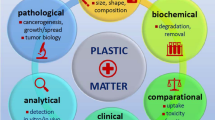Summary
[1,2-14C] Vinyl chloride and [1,2-14C] trichloroethylene were incubated with rat liver microsomes, NADPH and RNA (from yeast). Whereas trichloroethylene metabolites were irreversibly bound to proteins in microsomal incubations to a higher extent than vinyl chloride metabolites, irreversible binding to RNA was lower for trichloroethylene metabolites. Hydrolysis of the RNA which was reisolated from microsomal incubations with 14C-vinyl chloride or 14C-trichloroethylene and separation of the nucleosides showed different alkylation products arising from vinyl chloride and from trichloroethylene, characteristic for vinyl chloride being formation of 1,N6-ethenoadenosine and 3,N4-ethenocytidine. The different reactivities of metabolites of vinyl chloride and of trichloroethylene prompted a comparison of the oncogenic effects of both compounds against the rat liver cell. Newborn rats were exposed for 10 weeks to 2000 ppm vinyl chloride or trichloroethylene (8 h/day; 5 days/week). After this period livers of the animals were stained for nucleoside-5-triphosphatase. Whereas the vinyl chloride exposed rats showed focal hepatocellular deficiencies in this enzyme, which are supposed to represent an early sign of malignancy, no such changes were induced by trichloroethylene exposure. The data therefore suggest differences between the hepatocarcinogenic activity of vinyl chloride and possible effects of trichloroethylene on the liver.
Similar content being viewed by others
References
Barbin, A., Brésil, H., Croisy, A., Jacquignon, P., Malaveille, C., Montesano, R., Bartsch, H.: Liver microsome mediated formation of alkylating agents from vinyl bromide and vinyl chloride. Biochem. Biophys. Res. Commun. 67, 596–603 (1975)
Börner, P., Gössner, W.: Enzymhistochemische Untersuchungen der Adenosintriphosphatase, der Succinodehydrogenase sowie der alkalischen und sauren Phosphatase im Leberparenchym der Ratte während der Einwirkung des Carcinogens Diäthylnitrosamin. Z. Naturforsch. 236, 1085–1091 (1961)
Bolt, H.M., Buchter, A., Wolowski, L., Gil, D.L., Bolt, W.: Incubation of 14C-trichloroethylene vapor with rat liver microsomes: Uptake of radioactivity and covalent protein binding of metabolites. Int. Arch. Occup. Environ. Health 39, 103–111 (1977)
Bonse, G., Henschler, D.: Chemical reactivity, biotransformation, and toxicity of polychlorinated aliphatic compounds. CRC Crit. Rev. Toxicol. 5, 395–409 (1976)
Friedrich-Freksa, H., Gössner, W., Börner, P.: Histochemische Untersuchungen der Cancerogenese der Rattenleber nach Dauergaben von Diäthylnitrosamin. Z. Krebsforsch. 72, 226–239 (1969a)
Friedrich-Freksa, H., Papadopulu, G., Gössner, W.: Histochemische Untersuchungen der Cancerogenese in der Rattenleber nach zeitlich begrenzter Verabfolgung von Diäthylnitrosamin. Z. Krebsforsch. 72, 240–253 (1969b)
Greim, H., Bonse, G., Radwan, Z., Reichert, D., Henschler, D.: Mutagenicity in vitro and potential carcinogenicity of chlorinated ethylenes as a function of metabolic oxirane formation. Biochem. Pharmacol. 24, 2013–2017 (1975)
Henschler, D., Eder, E., Neudecker, T., Metzler, M.: Carcinogenicity of trichloroethylene: Fact or artifact? Arch. Toxicol. 37, 233–236 (1977)
Henschler, D., Hoos, W. R., Fetz, H., Dallmeier, E., Metzler, M.: Reactions of trichloroethylene epoxide in aqueous systems. Biochem. Pharmacol. 28, 543–548 (1979)
Kappus, H., Bolt, H.M., Buchter, A., Bolt, W.: Rat liver microsomes catalyse covalent binding of 14C-vinyl chloride to macromolecules. Nature 257, 134–135 (1975)
Kappus, H., Bolt, H.M., Buchter, A., Bolt, W.: Liver microsomal uptake of 14C-vinyl chloride and transformation to protein alkylating metabolites in vitro. Toxicol. Appl. Pharmacol. 37, 461–471 (1976)
Kunz, W., Stöckle, G., Appel, K.: Quantitative analyses of enzyme-deficient cell areas to assess early precancerous alterations of hepatocarcenogenic substances. Naunyn-Schmiedeberg's Arch. Pharmacol. (Suppl.) 293, R65 (1976)
Laib, R.J., Bolt, H.M.: Alkylation of RNA by vinyl chloride metabolites in vitro and in vivo: Formation of 1,N6-ethenoadenosine. Toxicology 8, 185–195 (1977)
Laib, R.J., Bolt, H.M.: Formation of 3,N4-ethenocytidine moieties in RNA by vinyl chloride metabolites in vitro and in vivo. Arch. Toxicol. 39, 235–240 (1978)
Maltoni, C.: Recent findings on carcinogenicity of chlorinated olefins. Presented at the Conference on Comparative Metabolism and Toxicity of Vinyl Chloride Related Compounds, May 2–4, 1977, Bethesda, Md. Env. Hlth. Perspect. 21, 1–5 (1977)
NCI, National Institutes of Health, US Dept. of Health, Education and Welfare: Carcinogenesis bioassay of trichloroethylene. Carcinogenesis Technical Report Series, No.2. Washington, D.C.: US Government Printing Office 1976
Remmer, H., Greim, H., Schenkman, J.B., Estabrook, R.W.: Methods for the elevation of hepatic microsomal mixed function oxidase levels and cytochrome P-450. Methods Enzym. 10, 703–708 (1967)
Schauer, A., Kunze, E.: Enzymhistochemische und autoradiographische Untersuchungen während der Cancerisierung der Rattenleber mit Diäthylnitrosamin. Z. Krebsforsch. 70, 252–266 (1968)
Uehleke, H., Tabarelli-Poplawski, S.: Irreversible binding of 14C-labelled trichloroethylene to mice liver constituents in vivo and in vitro. Arch. Toxicol. 37, 289–294 (1977)
Uehleke, H., Tabarelli-Poplawski, S., Bonse, G., Henschler, D.: Spectral evidence for 2,2,3-trichlorooxirane formation during microsomal trichloroethylene oxidation. Arch. Toxicol. 37, 95–105 (1977)
Van Duuren, B.L.: On the possible mechanism of carcinogenic action of vinyl chloride. Ann. N.Y. Acad. Sci. 246, 258–267 (1975)
Van Duuren, B.L., Banerjee, S.: Covalent interaction of metabolites of the carcinogen trichloroethylene in rat hepatic microsomes. Cancer Res. 36, 2419–2422 (1976)
Wachstein, M., Meisel, E.: On the histochemical demonstration of glucose-6-phosphatase. J. Histochem. Cytochem. 4, 592 (1956)
Wachstein, M., Meisel, E.: Histochemistry of hepatic phosphatases at a physiological pH with special reference to the demonstration of bile canaliculi. Am. J. Clin. Pathol. 27, 13–23 (1957)
Author information
Authors and Affiliations
Rights and permissions
About this article
Cite this article
Laib, R.J., Stöckle, G., Bolt, H.M. et al. Vinyl chloride and trichloroethylene: Comparison of alkylating effects of metabolites and induction of preneoplastic enzyme deficiencies in rat liver. J Cancer Res Clin Oncol 94, 139–147 (1979). https://doi.org/10.1007/BF00422494
Received:
Accepted:
Issue Date:
DOI: https://doi.org/10.1007/BF00422494




